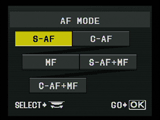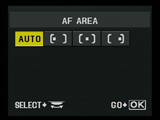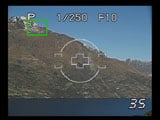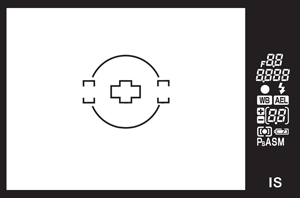Olympus E-510
-
-
Written by Gordon Laing
Olympus E-510 lenses
More Features : Lenses and viewfinder / Screen and menus / Sensor and processing / Anti dust / Anti shake
Olympus E-510 features continued…
Lenses and viewfinder / Screen and menus / Sensor and processing / Anti dust / Anti shake
The Olympus E-510 employs a Four Thirds lens mount and is compatible with the complete range of Four Thirds lenses which at the time of writing totalled 23 from Olympus (including tele-converters and recently-announced models), 11 from Sigma and two from Panasonic / Leica. All these lenses are designed from the ground-up for DSLR use and many offer compelling facilities or features – to find out more about one of our favourite models, check out our Olympus Zuiko Digital 7-14mm review which has been fully updated with new samples and a video tour.
Like other Four Thirds DSLRs, the E-510’s sensor size effectively reduces the lens field of view by two times, so the optionally-bundled Zuiko Digital ED 14-42mm kit lens delivers a 35mm equivalent focal length of 28-84mm. The range of the kit lens in practice is illustrated below.
Olympus E-510 with Zuiko Digital ED 14-42mm coverage | ||
 |  | |
| 14-42mm at 14mm, f8 (28mm equivalent) | 14-42mm at 42mm, f8 (84mm equivalent) | |
Olympus sells the E-510 as a body alone, or in two different lens kits, one with the ED 14-42mm and the other with both the ED 14-42mm and the ED 40-150mm. These are new kit lenses first introduced with the E-400 and employ ED glass elements to correct for colour and other optical aberrations; the ED prefix also helps differentiate them from older Zuiko Digital kit lenses, especially as some store bundles may vary. Both new kit lenses also feature internal focusing and come supplied with lens hoods – rival manufacturers take note!
The new kit lenses are smaller and lighter than their predecessors, perfectly matching the compact dimensions of the E-400 and E-410. Mounted on the chunkier E-510, they look small but certainly not out of proportion – and as discussed on the previous page, the E-510 feels much better equipped to handle bigger, heavier lenses than the E-410 / E-400.
We were impressed by the performance of the new kit lenses and the twin lens kit represents particularly good value. To see how the ED 14-42mm lens performs against tough competition, check out our Leica D 14-50mm review
Olympus E-510
auto-focusing
 |
 |
Like all Four Thirds bodies produced so far, the E-510 employs a fairly basic 3-point auto-focus system. This makes it considerably less sophisticated than the nine and 11-point AF systems of rivals like the Canon EOS 400D / XTi and Nikon D80 respectively. That said, like the 3-point system of the Nikon D40(x), the E-510’s auto-focus is fine for general use but if you’re into tracking moving or off-centre subjects, the 400D / XTi or D80 could be a better bet.
One of the more useful AF features inherited from the E-500 is the E-510’s Release Priority option which allows the camera to take a photo even if the AF system hasn’t yet locked onto a subject. Like its predecessor, the E-510 has separate Release Priority settings for Single and Continuous auto-focusing modes, and these will be welcomed by anyone for whom instant response takes priority over, say, a pin-sharp shot of someone’s back.
Olympus E-510
manual focusing
Again like all Four Thirds bodies so far, the E-510’s manual focusing is motor-assisted. This can feel quite odd if you’re used to traditional mechanical systems and also has quirks like not being adjustable unless the camera’s switched on. By default, the lenses also reset their focus to infinity with a ‘zz-zz’ sound when you power-off the body, although like its predecessor, the E-510 allows you to disable this in a menu if desired.
Another feature inherited from the E-500 which isn’t present on the E-410 is the ability to choose whether the focusing ring operates in a clockwise or anti-clockwise direction. This can be quite eerie though for lenses with focusing distances marked behind a small window – imagine turning the focusing ring one way and seeing the focusing distance marks turn the other. The manual focus bracketing option of the earlier E-500 is not present here though.
 |
 |
The E-510’s Live View facility also allows you to magnify a small area for manual focus assistance. Like the E-410, you can move a green rectangle to the desired area, then press the OK button to magnify it by seven or ten times. This is a handy facility to have, and while relatively common on the better compact cameras, it’s pretty unique for a DSLR.
So there’s certainly some interesting options on the E-510, but if manual focusing is very important to you and you’ve not used a Four Thirds body before, we’d recommend trying one in person first – while it’s certainly possible to manually focus accurately with the E-510, some people just might not get on with the implementation.
Olympus E-510 viewfinder
The Olympus E-510 shares the same optical viewfinder as the E-410, employing a Penta-mirror system to deliver 95% coverage and 0.92x magnification with a 50mm lens set to infinity.
 |
Like other DSLRs based on the Four Thirds standard, the E-510’s actual viewfinder view itself can appear smaller than other DSLRs. Due to the squarer 4:3 aspect ratio of their images, the viewfinder frame is slightly narrower than the 3:2 shape of rival models. Since most DSLRs with their cropped sensors already have relatively small apparent frame areas to start with, the Four Thirds ones unfortunately look smaller still.
In practice, the E-510’s viewfinder appears around the same height as the Canon EOS 400D / XTi, although slightly narrower. The Nikon D80 still wins in this respect with the biggest, brightest viewfinder of all cropped-frame DSLRs, but at least the E-510’s viewfinder, like the E-410, is a great improvement over the earlier E-330 and Panasonic L1.
The ‘spare’ space to the right side of the E-510’s squarish viewfinder frame is used to display shooting information consisting of the aperture, shutter, exposure mode, metering mode, exposure compensation (expressed numerically up to +/-5EV), and a battery icon. You won’t find the ISO displayed in the viewfinder, but it is at least shown on the main screen at all times. This makes the E-510’s viewfinder identical to the E-410, apart from the small addition of the Image Stabilisation mode under the main characters; unlike the Sony A100 though, there’s no indication of how hard the system’s working.
While the optical viewfinder has often been an area of criticism on Four Thirds bodies, the E-510, like the E-410, has one major trump card: its Live View facility allows you to alternatively compose shots using the main colour monitor, and we’ll fully cover this facility on the next page.




